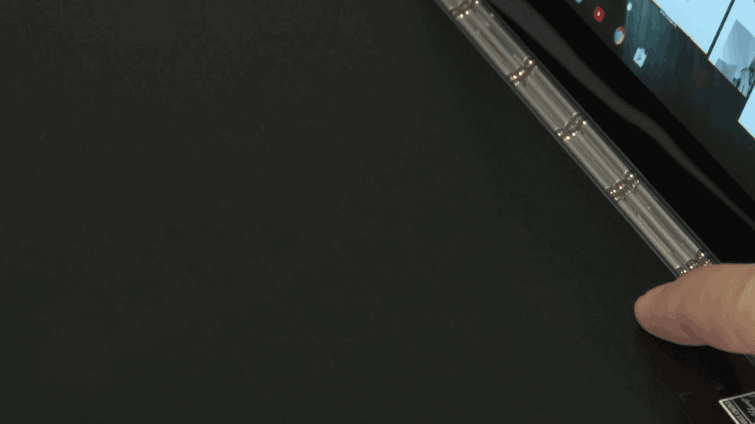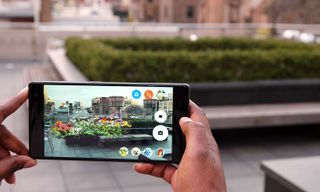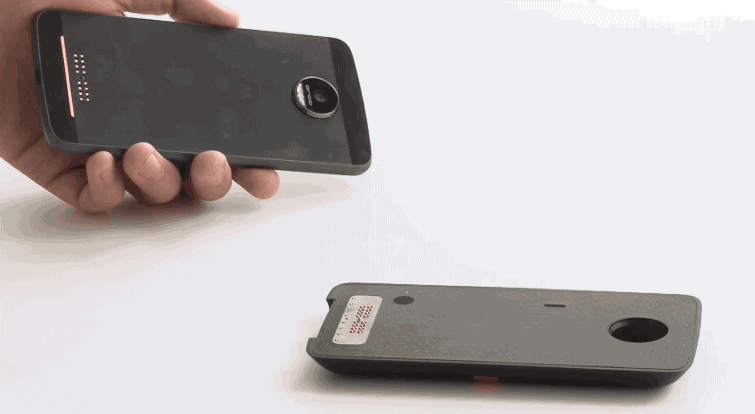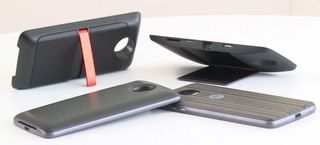The Most Innovative Tech Company of 2016? It's Lenovo
By reinventing both 2-in-1s with the Yoga Book and phones with the Phab 2 Pro and Moto Z, Lenovo out-innovated the competition this year.
While other tech companies merely spit out iterations of existing products in 2016 — waterproofing an identical phone or slimming down their laptops and tablets — Lenovo was busy reinventing these categories with bold new gadgets in 2016. That's why we're giving the company Tom's Guide's first annual Most Innovative Company of the Year award.

Lenovo took bold risks in two key categories with three devices:
- Yoga Book: A 2-in-1 sporting a completely flat keyboard that transforms into a writing pad you can use with a real pen. Android and Windows versions are available now, and Lenovo confirmed that a Chrome OS edition is on the way for 2017.
- Phab 2 Pro: The first true augmented-reality phone, which leverages Google's Tango depth-sensing technology.
- Moto Z: A phone that lets you add mods (and new capabilities) via an intuitive magnetic system.
"Lenovo is definitely innovating," said Avi Greengart, research director for consumer platforms and devices at market research firm Current Analysis.
Jeff Meredith, general manager and vice president of Lenovo's Android and Chrome Computing Business Group, knows that this trio of groundbreaking products isn't for everyone. But he cited a quote by Amazon's Jeff Bezos: "If you never want to be criticized, for goodness' sake, don't do anything new."
Yoga Book: A Retro (and Futuristic) 2-in-1
The Yoga Book is different from every other 2-in-1 hybrid we've tested, and that's because of the way it combines new and old as well as new input methods. For starters, you can draw, sketch or take notes on this device (available in Android and Windows varieties) using real ink and paper, which magnetically attaches to the bottom of this very sleek 1.5-pound device. The Yoga Book will digitize it all for safekeeping.

Meredith said the device bridges an important gap for a sizable consumer group.
"One of the things that we found is that a lot of people actually like to write in pen on paper," he said. "So rather than try to force people down a path of changing behavior, we figured out a way to integrate that behavior into our device."
MORE: Best 2-in-1s (Laptop/Tablet Hybrids)
You don't have to use old-school paper, though. The so-called Create Pad portion beneath the screen also doubles as a Wacom drawing pad, giving digital artists real precision with 2,048 levels of pressure. Meredith said he's been pleasantly surprised by how many early Yoga Book owners are either semiprofessional digital artists or just have a passion for digital art.
Things get even more interesting when you press a button on the pad, which lights up the Halo keyboard. It's completely flat, which is quite a departure from the company's legacy ThinkPad keyboards. Lenovo explicitly targeted 13- to 24-year-olds, who are accustomed to typing on a touch screen. As we noted in our review, this is not a layout for touch typists. Nonetheless, Meredith said users' reactions to the keyboard have been more positive than he had anticipated.

"You know that a touch-based keyboard is very different" from a traditional keyboard, Meredith said. But most people who used the keyboard for even just a few hours said they enjoyed the experience, he added.
Stephen Baker, the primary hardware analyst at research firm NPD, called the Yoga Book "interesting, innovative and maybe a little ahead." But he also said he wonders if it is "too different" for the customers Lenovo is trying to reach.
Although Meredith said U.S. Yoga Book sales have been "just average," Lenovo is definitely forging ahead. The product's retail sales are expanding beyond Walmart in the U.S., where it has been available exclusively. Plus, Lenovo will be offering this 2-in-1 in a new flavor: Chrome OS. The product should hit the market by midyear.
MORE: Lenovo Yoga Book (Windows): Full Review and Benchmarks
The company is evaluating how the evolution of Google’s platforms will impact future versions of the Yoga Book.
"Over time, we probably see the Android and Chrome versions melding together, especially based on the fact that we've now seen Chrome roll out the Google Play store capability into Chrome," Meredith told Tom's Guide. "We'll probably maintain the three distinctive products throughout the next year at least."
Lenovo Phab 2 Pro: Augmented Reality Way Beyond Pokémon Go
Walk with giant dinosaurs. Redecorate your house with new furniture. Shoot at killer robots. The Lenovo Phab 2 Pro is a big deal for augmented reality and mixed reality, as it turns the world around you into a virtual playground for doing all sorts of things that just aren't possible with a typical phone. And no geeky headset is required.

The key ingredient is Tango, a technology developed by Google that uses a combination of two cameras with a special depth sensor. That's why you can try out that handsome new sofa in the corner of your living room with the Lowe's Vision app without breaking a sweat. The phone measures the room in real time as you move around.
"A wide-angle lens can give you a broad field of view, but what enables Tango to have contextual understanding is the depth sensing," Meredith said. "If you don't have everything properly synced, the device's understanding of your precise location falls apart."
Google had demonstrated Tango in a small tablet, but Lenovo worked more than six months to make the tech ready for mass production in a phone. Granted, at 6.4 inches, it is a huge phone — but this is just the first generation.
That's not the only challenge for Lenovo. There are only about 36 Tango-enabled apps in the Google Play store. "Tango is still experimental and is caught in a catch-22: There are few apps, and few devices to justify developing apps," Greengart said.
MORE: Lenovo Phab 2 Pro Review: The Future of AR
Lenovo is addressing this issue head-on. The company had 4,000 developers purchase its Tango device to create new experiences, and an additional 2,000 purchased the device at a second hackathon.
Meredith also noted that Lenovo will release a follow-up Tango phone in 2017, and the company expects similar products from competitors. "I think it will keep us ahead of where some others are," Meredith said. "You're going to see new devices, Tango devices, in 2017, that aren't from Lenovo."
Moto Z: Smarter Modular Thinking
Although Google backed away from its own modular-phone effort in 2016, dubbed Project Ara, other companies launched their own initiatives. The goal: add new capabilities to your handset without requiring you to buy a whole new device.
LG attempted first, with its G5. But the device's design was awkward, requiring users to remove the battery and power down the phone to swap in some new modules. Lenovo's Moto Z, by contrast, is much simpler and straightforward, because its Moto Mods attach via magnets. They're a cinch to snap on, even if they take a bit of effort to pull apart.

The Moto Mods range from a snap-on power pack from Mophie and a powerful JBL speaker (both $80) to a Hasselblad camera with a 10x zoom ($249) and a mini projector ($299). Those add-ons are fairly pricey, but Style Mods (e.g., cases for the back) start at $39.
John Touvannas, senior director of product management at Lenovo's Motorola Mobility division, said the company wanted to take a new approach to innovation.
"Moto Mods was our opportunity to take a stand against incrementalism plaguing the industry," he said. "We didn't just start with gimmicks or add-ons that might look cool in a store. We honed in on real consumer pain points and created an ecosystem that complements the user experience."
MORE: Best Smartphones - Here Are the 10 Best Phones Available
The biggest challenge in creating the Moto Z was keeping the device very thin and light so that it didn't feel like a brick when you attached Mods. Lenovo reps said this required ditching the headphone jack — a move Apple also made with the iPhone 7.
So far, the Battery Power Packs and JBL SoundBoost are the top-selling Moto Mods, according to Touvannas.

There are two main obstacles the Moto Z faces. First, it's sold through only one wireless carrier in the U.S. (Verizon), although you can buy it unlocked. Second, its main new Android rival on Verizon — the Google Pixel — is a huge hit.
"The Moto Z is absolutely the best implementation of modular accessories, but an accessories ecosystem is only valuable when you have a market-leading product," Greengart said. "Most consumers walk into retail asking about Apple or Samsung, and if a carrier rep has only one opportunity to present an alternative, Lenovo needs to capitalize on it — and thanks to Google's Pixel, that is not happening."
MORE: Moto Z Force and Moto Z Droid Review: Modularity Done Right
Despite these headwinds, Motorola is determined to continue innovating with modular phones, and as Motorola and Lenovo become more integrated, a Google Tango Mod likely will be released in the coming year. "There is certainly opportunity to have Tango embedded in a mod," Meredith said. Motorola also has teamed up with crowdfunding site Indiegogo to further spur mod development.
"Building a new mobile hardware ecosystem takes time and requires multiple strategies for growth, including new partnerships and collaborations with third parties," Touvannas said.
Sign up to get the BEST of Tom’s Guide direct to your inbox.
Upgrade your life with a daily dose of the biggest tech news, lifestyle hacks and our curated analysis. Be the first to know about cutting-edge gadgets and the hottest deals.
Mark Spoonauer is the global editor in chief of Tom's Guide and has covered technology for over 20 years. In addition to overseeing the direction of Tom's Guide, Mark specializes in covering all things mobile, having reviewed dozens of smartphones and other gadgets. He has spoken at key industry events and appears regularly on TV to discuss the latest trends, including Cheddar, Fox Business and other outlets. Mark was previously editor in chief of Laptop Mag, and his work has appeared in Wired, Popular Science and Inc. Follow him on Twitter at @mspoonauer.

